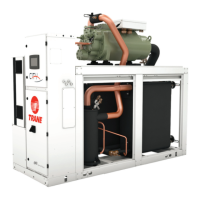31
RLC-SVX023B-GB
Operating Principles Mechanical
Oil Management System
Oil Separator
The oil separator consists of a vertical tube, joined at the top by the refrigerant discharge line from the compressor.
This causes the refrigerant to swirl in the tube and throws the oil to the outside, where it collects on the walls and
fl ows to the bottom. The compressed refrigerant vapor, stripped of oil droplets, exits out the top of the oil separator
and is discharged into the condenser.
Oil that collects in the bottom of the oil separator at condensing pressure during compressor operation; therefore,
oil is constantly moving to lower pressure areas.
Oil Flow Protection
Oil fl ow and quality is proven through a combination of a number of sensors, most notably a pressure transducer.
If for any reason oil fl ow is obstructed because of a plugged oil fi lter, closed service valve, faulty master solenoid, or
other source, the oil pressure transducer will read an excessively high pressure drop in the oil system (relative to the
total system pressure) and shut down the chiller.
To ensure the required system differential pressure is adequate to move oil to the compressor, the Tracer UC800
attempts to both control a minimum system differential pressure as well as monitor it. Based on readings from
pressure transducers in both the evaporator and condenser. Once the minimum is met, the EXV will return to normal
liquid level control (see the paragraph on “Cycle Description”). If the differential is signifi cantly lower than required,
the unit will trip and initiate appropriate diagnostics and would enforce a compressor “cool down” period. To ensure
proper lubrication and minimize refrigerant condensation in the oil sump, heaters are mounted on the bottom of
the oil sump. An auxiliary contact of the compressor starter, energizes these heaters during the compressor off
cycle to maintain a proper elevation of the oil temperature. The heater element is continuously energized while
the compressor is off and does not cycle on temperature.
Oil Filter
All chillers are equipped with replaceable-element oil fi lters. Each removes any impurities that could foul the
compressor internal oil supply galleries. This also prevents excessive wear of compressor rotor and bearing surfaces
and promotes long bearing life. Refer to maintenance section for recommended fi lter element replacement intervals.
Compressor Rotor Oil Supply
Oil fl owing through this circuit enters the compressor rotor housing. From there it is injected along the rotors to seal
clearance spaces around the rotors and lubricate the contact line between the male and female rotors.
Lubricant Recovery
Despite the high effi ciency of the oil separators, a small percentage of oil will get past them, move through the
condenser, and eventually end up in the evaporator. This oil must be recovered and returned to the oil separator.
The function of oil return is accomplished by the BPHE that will push the oil with the evaporated refrigerant through
the suction line to the compressor.
Oil Cooler
The oil cooler is a brazed plate heat exchanger designed to transfer 3.5 kW of heat from the oil to the suction side of
the system. Subcooled liquid is the cooling source. The oil cooler is required on units running at high condensing or
low suction temperatures. The high discharge temperatures in these applications increase oil temperatures above
the recommended limits for adequate lubrication and reduce the viscosity of the oil.

